Fort Rice was the first of the Army posts built along the Upper Missouri RiverFrom 1864 to 1878, Fort Rice was a site of both cultural contact and armed conflict. The Western Dakota Sioux, also called the Teton Dakotas, or Lakotas, claimed the land surrounding the fort as part of their traditional lands. This area was given legal status as Lakota tribal lands by the Treaty of Fort Laramie of 1851.
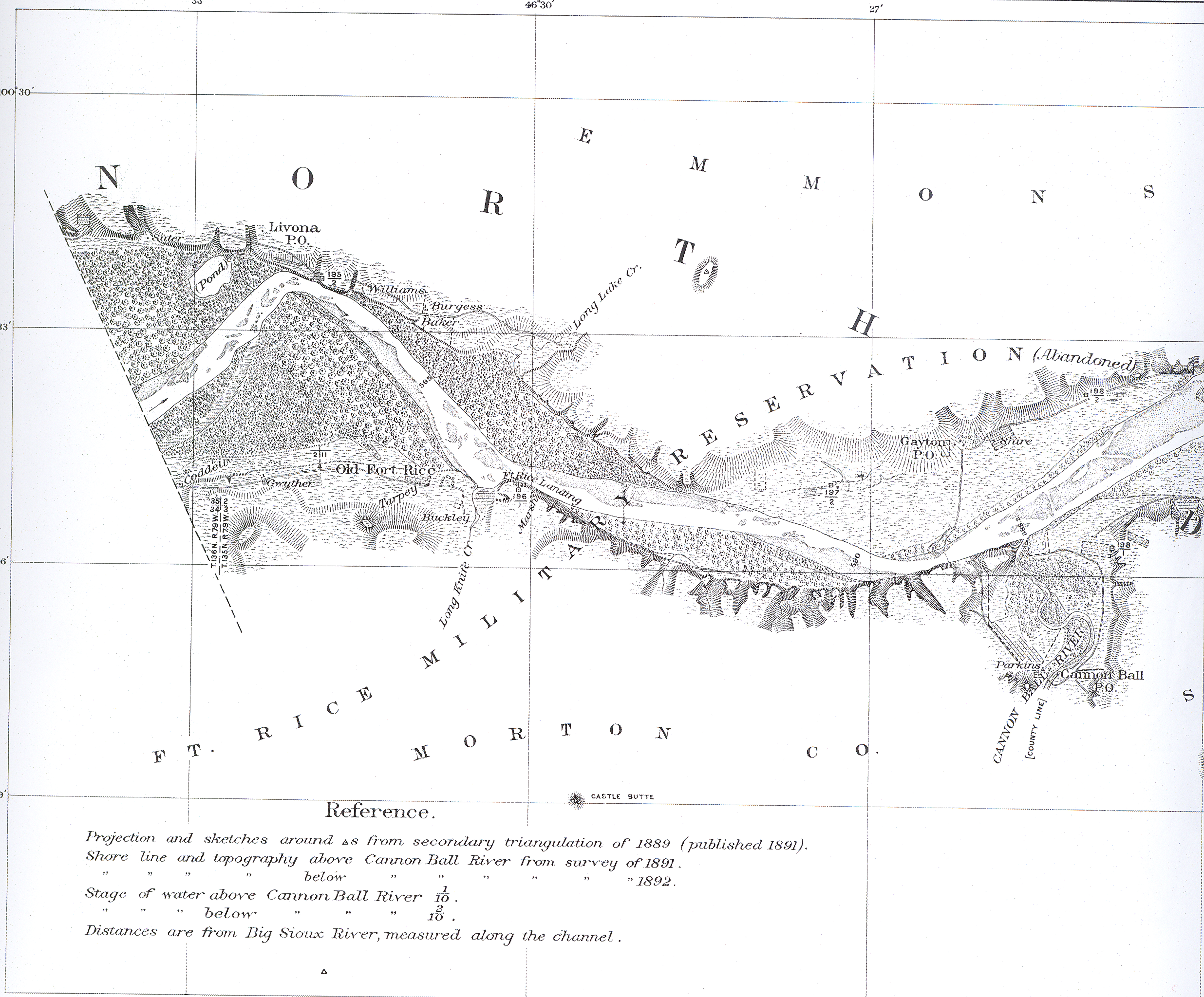
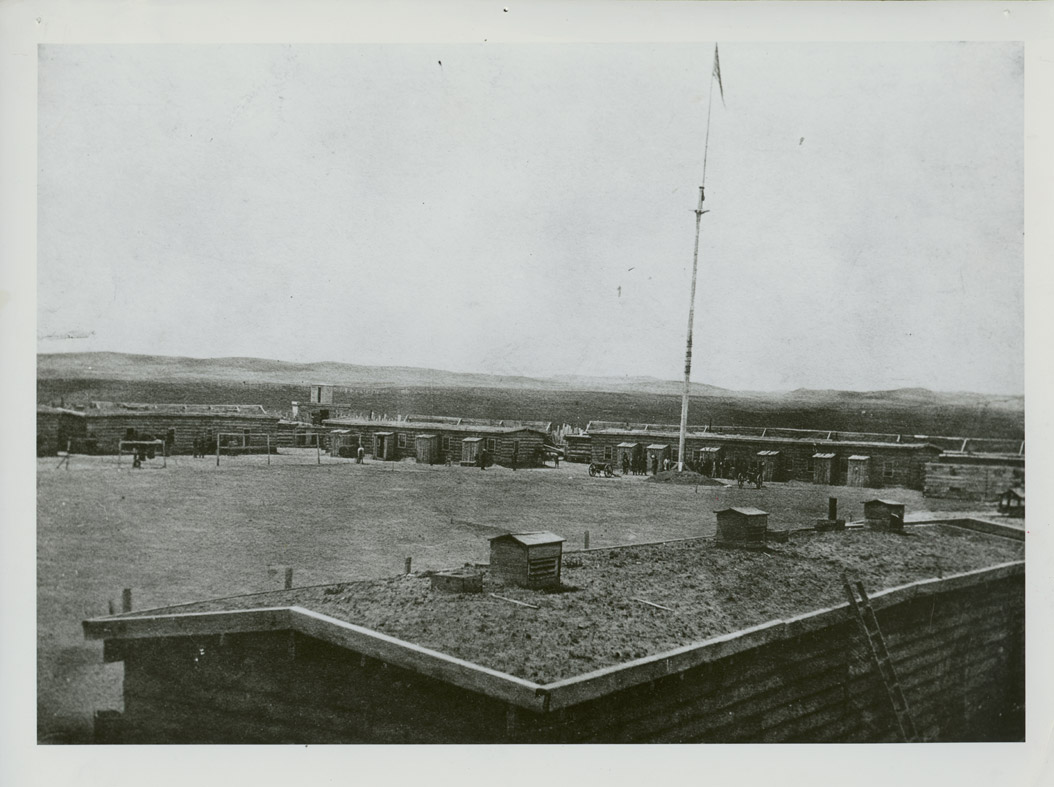
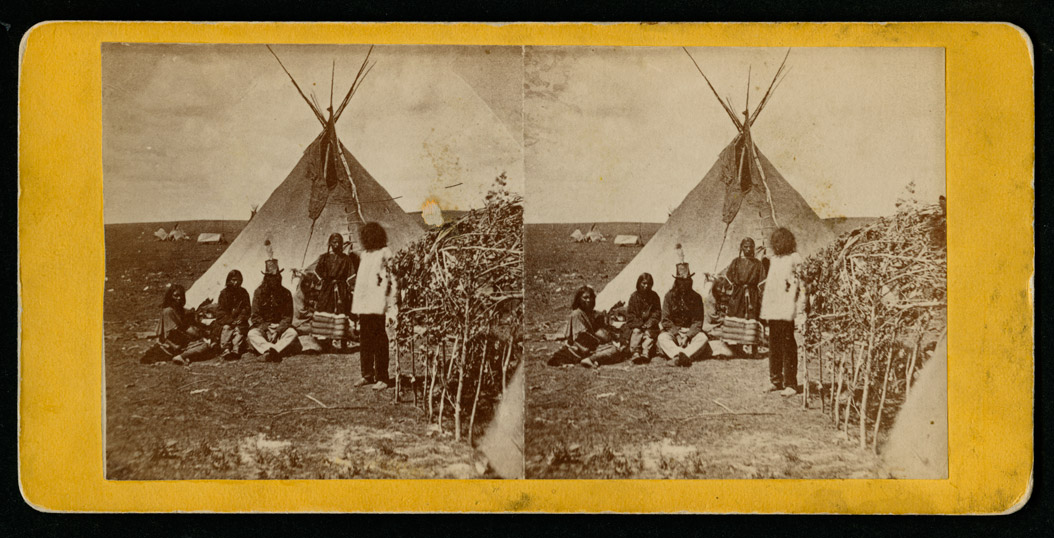
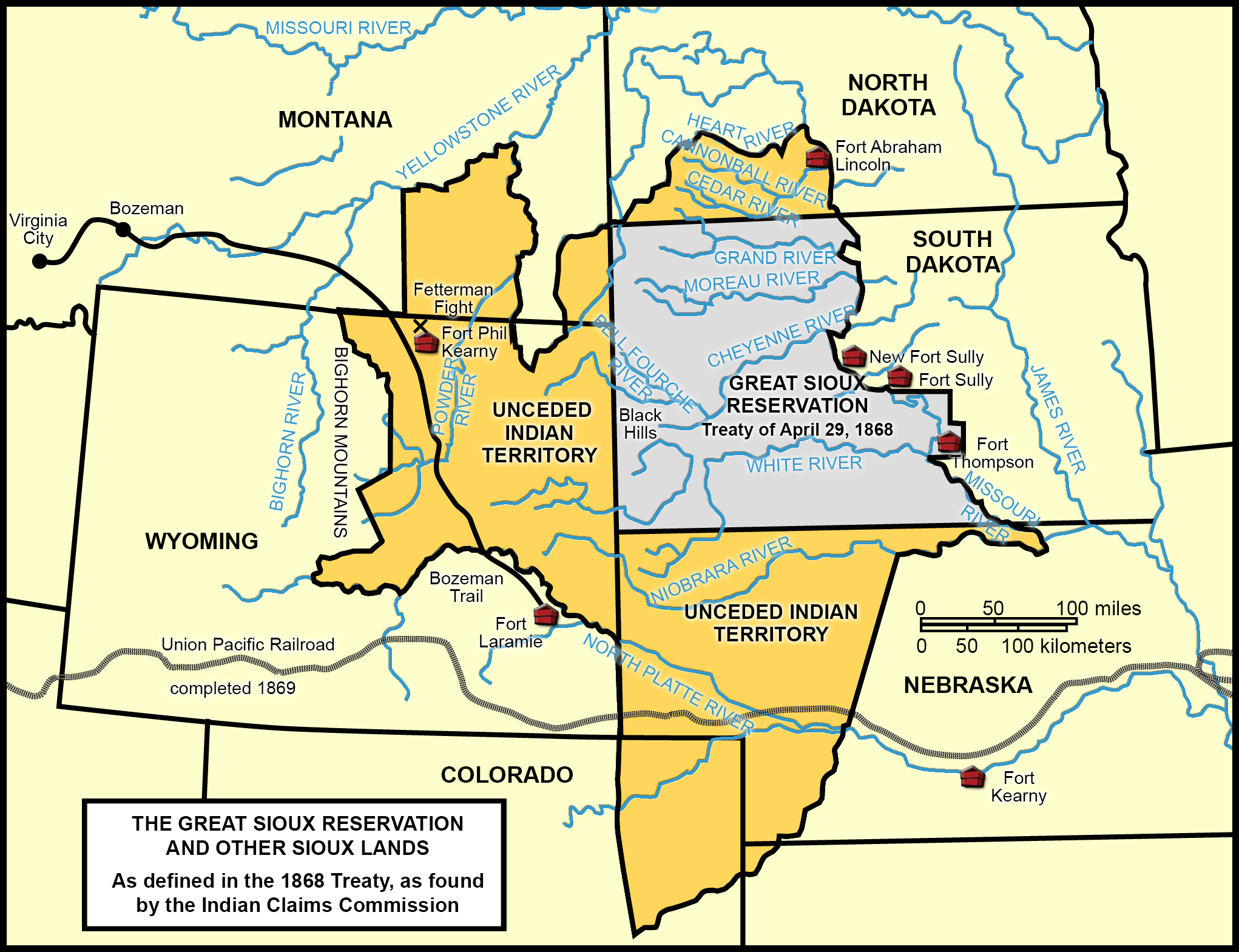
When General Alfred Sully led the Northwest Indian Expedition up the Missouri River in 1864, he had orders to find locations for Army posts along the Missouri River. Sully chose a spot on the west bank of the Missouri River for Fort Rice. The fort was located just north of the mouth of the Cannonball River and south of the mouth of the Heart River.
Fort Rice was on the high banks above annual spring floods. There was wood nearby on the lower banks of the river. The post’s military reservation extended across the river. (See Map 2.) Until the post was abandoned in 1878, no settlement could take place in the fort's reserved territory.
The 30th Wisconsin Volunteers (in the U.S. Army) built the fort of cottonwood logs. (See Image 7.) When the post was completed, the First U.S. Volunteers were sent to live and work at Fort Rice. The First U.S. was an infantry unit formed of Confederate soldiers who had been imprisoned in Maryland. When given an opportunity to put on a Union Army uniform, several hundred former Confederate soldiers signed up. They were sent to Dakota Territory to avoid sending them into battle against Confederate troops.
The first winter at Fort Rice was horrible. Eighty-one men died during the winter. Most died of scurvy, a disease resulting from poor nutrition. The fort also came under nearly constant attack by Lakotas who who rightly believed that the fort was a violation of the Fort Laramie Treaty. The Lakotas fought in their accustomed manner. They made small attacks in which they tried to drive off or kill livestock. They occasionally attacked soldiers who were far from the fort on duty or hunting. Leaders of different bands of Lakotas also approached the fort for discussions with the commanding officer. The Lakotas challenged the Army’s presence and demanded removal of the fort. (See Image 8.)
In 1865, territorial governor Newton Edmunds asked the Lakota Sioux to sign a treaty. Edmunds believed that ending the constant conflict would promote business and settlement in Dakota Territory. The treaty council did not include representatives of the U.S. Commissioner of Indian Affairs. The most important Lakota leaders did not attend the councils. Sitting Bull, a leader of the Unkpapa (or Hunkpapa) Lakotas, was becoming known for his opposition to the U.S. government and the Army. He was at the Battle of Killdeer Mountain and participated in the siege of a wagon train at Fort Dilts. He led some of the attacks at Fort Rice in the summer of 1865. Without his signature, the treaties had little effect.
In 1868, a far more important treaty was signed at Fort Rice. The Treaty of Fort Laramie of 1868 was brought to Fort Rice for the signatures of the Lakotas who had not signed during the treaty conference in Wyoming. Major Galpin, a Fort Rice trader, and his wife, Matilda, (a Lakota woman also known as Eagle Woman) helped to gather the distant bands to the fort for the treaty council. Fifty thousand Sioux met at Fort Rice on July 2, 1868. Running Antelope and Two Bears signed this treaty. Sitting Bull did not attend, but sent Gall in his place.
The treaty of 1868 created the Great Sioux Reservation (See Map 3.) which covered parts of the present-day states of North Dakota, South Dakota, Wyoming, Montana, and Nebraska. The U. S. government agreed to remove Army posts from the Bozeman Trail which ran through Wyoming to the gold fields of Montana. Sioux attacks on Army posts and wagon trains on the trail had succeeded in driving the government and the Army out of Sioux territory.
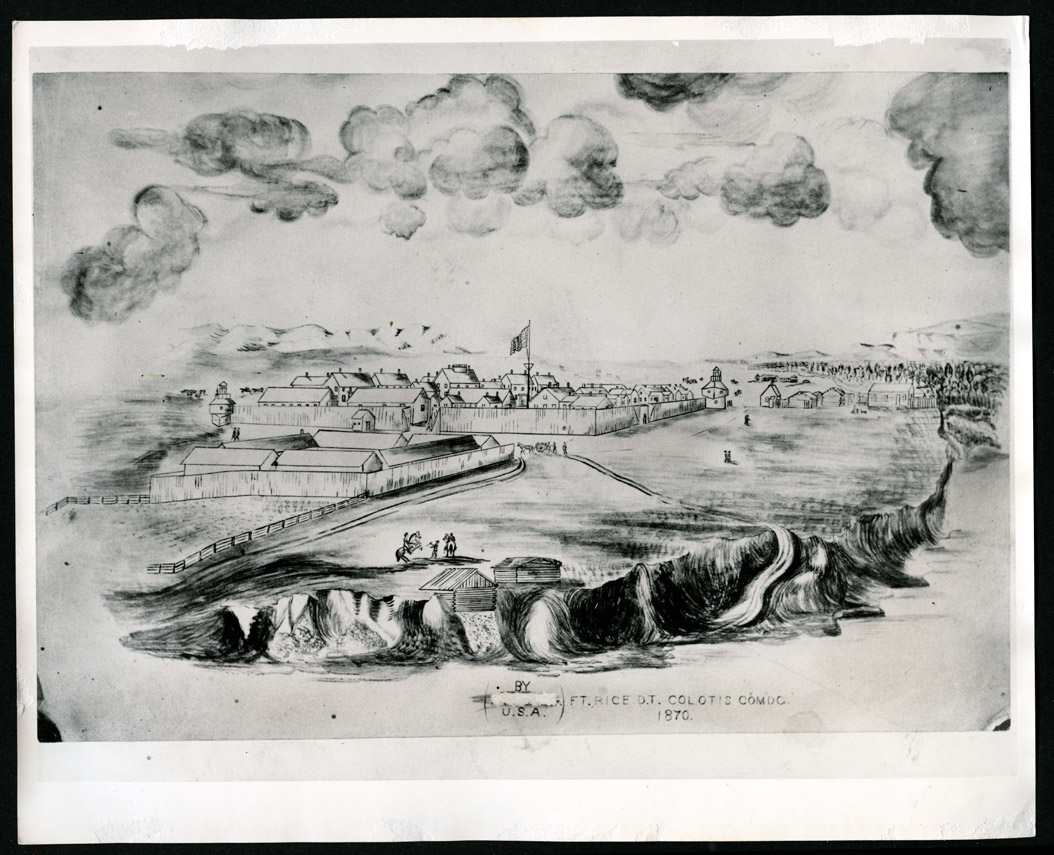
Fort Rice remained vitally important in the 1870s. (See Image 9.) Soldiers from the fort provided protection for railroad surveyors and construction crews. Fort Rice soldiers accompanied Colonel Custer on an exploratory expedition to the Black Hills in 1874. Throughout these years, the Sioux continued to drive away or kill the post’s livestock. In 1872, Lakotas tried to set fire to the wooden stockade surrounding the post.
Fort Rice began to lose its prominent position in the mid-1870s. In 1874, the Grand River Indian Agency relocated to Standing Rock reservation 32 miles south of Fort Rice. The Army post established with the agency was called Fort Yates. Fort Yates became more and more important because it was the home to the Unkpapas and other important and powerful bands of Lakotas. Finally, in 1878, Fort Rice was abandoned by the Army. However, the Army retained control of the military reservation. In 1884, the 112,363 acres of the military reservation was finally released and opened to public use.
Why is this important? The Missouri River forts included Rice, Abraham Lincoln, Stevenson, and Buford. Each fort had an important role to play in protecting commerce, advancing Anglo-American settlement, and establishing the power of the United States government over American Indian tribes in the region. The Lakotas focused their attacks on Fort Rice because of its location and because it was the first to be built along the Upper Missouri River.
The history of Fort Rice is short. The fort’s history reflects the rapid pace of cultural, political, and economic change in northern Dakota Territory after the Civil War. Fort Rice was the first step in reducing the power of the Lakotas to resist the United States government and the growth of white settlement in the land west of the Missouri River.
Document 3. Excerpts from the diary of William L. Larned
William L. Larned, with wife, Julia, and son, Horatio, spent the summer of 1864 with the ill-fated FiskJames Fisk was a wagon train guide who had led several wagon trains of gold-seekers across northern Dakota Territory to the gold fields of Montana and Idaho. In 1864, he defied government orders and led his wagons on a different route through Sioux treaty lands. Near present day Amidon, the wagon train was attacked and several men were killed. The group struggled to continue onward for several days, but finally decided to stop and form fortifications between present day Rhame and Marmarth. For 16 days, they negotiated with the Sioux, but were unable to make progress. A few men volunteered to ride back to Fort Rice for help. Troops arrived on September 20. Fisk’s Overlanders were escorted back to Fort Rice. Many returned to St. Paul, but the Larneds decided to stay at Fort Rice where they engaged in trade and the sale of baked goods throughout the winter of 1864 -1865. expedition from Minneapolis. They were heading to the goldfields of Montana with supplies for miners. The Larneds returned to Fort Rice and spent the winter there. Fort Rice had been built during the summer and fall of 1864. It was isolated and poorly supplied during its first year.
Larned’s diary describes the way the Lakotas attacked Fort Rice in the winter of 1864-1865. Fort Rice had a stockade to protect the buildings and residents, but the cattle, horses, and hay were kept outside of the stockade under guard. The soldiers also had to leave the post to get water from the Missouri River and to cut wood for heat and cooking.
When the Lakotas attacked Fort Rice, they drove off or killed livestock. The Lakotas shot at and sometimes killed soldiers. These attacks followed the Lakota tradition of quick, small attacks on enemies. The Lakotas stated often that Fort Rice had been built on land guaranteed to them by the Treaty of Fort Laramie (1851). The tribe’s encounters with the Army at Whitestone Hill and Killdeer Mountain convinced them that having a military fort on their treaty lands would lead to more material losses for them. Larned’s entry of January 28, 1866 suggests that military presence had, indeed, contributed to the loss of their traditional food supplies. A treaty council held in the fall of 1865, helped to resolve the conflict.
This was a particularly important time for the Lakotas to attack. The post had been weakened by the deaths of dozens of men during the winter and spring due to poor nutrition which led to the disease called scurvy. The Teton Lakotas, including the Unkpapas, the Sans Arcs, and the Blackfeet, felt more hostile toward the government than did some other branches of the Dakotas. The Yanktonnai Dakotas, under the leadership of Two Bears, eventually accepted a peaceful relationship with the Army. Larned did not mention Sitting Bull, but the great Unkpapa leader was present on many of the days of conflict at Fort Rice.
Source: Ray H. Mattison, ed, “The Fisk Expedition of 1864: The Diary of William L. Larned,” North Dakota History Vol. 36, no. 3 (Summer 1969): 209-274.
- - - -
February 5, 1865. Sunday. I have been trying to get some tidings from my horse but so far in vain. The Indians are stealing animals almost daily. Night before last they took a fine horse & a span of mules that cost $400 from Frank LaFramboix. My horse may have been similarly appropriated. The old cow is down from the woods occasionally & doing tolerably well.
March 24. Friday. . . . The Mail Carrier who left the 12th inst [March 12] was attacked on his way down by a party of Santees & Unkpapas who disarmed & Seriously wounded him – took the mail bags cut them open & would have killed the one & destroyed the other had not Some friendly Indians Come to his aid who took the Carrier to their Camp & sent some of their party on with the mail to [Fort] Sulley. The Wounded Carrier arrived here last night.
April 4. Tuesday . . . . about midnight the garrison was turned out to repel an attack probably for the diversion of the officers. . .
April 9. Sunday. . . . on the 5th Indians drove off a quantity of Cattle. Major Galpin has 12 Cows left out of 40. During the storm many Cattle smothered in the snow My last animal - the cow- is now in the hands of the Indians. . .
April 14. Friday. . . 1 p.m. 100 Mounted Indians made a dash Killing 2 Men Capturing 40 or 45 horses & mules, Shooting dogs & cattle. The Wood detail gave them a warm reception but only one Indian is Known to be Killed. One of the Men Killed was Cool Calm & collected & was Conscious to the last moment. Said he Knew “Two Bears” & also Knew the Shirt he wore as the one the Colonel [Dimon] gave him last fall - & that it was he who shot himself & comrade and then returned & cut open the head of latter with his tomahawk. That another Indian was near, dressed in U.S. Cavalry clothing. P.M. the 2 Indian prisoners were shot by order of Colonel
April 26. Wednesday. Indians raid. Shot 2 oxen.
May 8. Monday. More cattle stolen to day by Indians. I think the herders made a mistake in reporting the circumstances.
May 9. Tuesday. . . . The Indian foray Yesterday was 3 dismounted Indians who drove off the last of the Beef Cattle. The 7 herders were probably attending to other duties. Of the Cattle driven off Some 3 weeks ago, 42 were drove into a snow bank where their ham Strings were cut & then left to the mercy of the Wolves.
May 20. Saturday. . . . Indians were out & shot a sentinel about midnight.
May 26. Friday. . . . 7 a m Indian attacked us again, fatally Wounding Lieut[enant] Wilson Co[mpany] C, Big Eagles party started out in pursuit at short notice. [This] even[i]ng Two Bears camp is being moved to this side & will encamp above us this may prove a kind of safeguard.
May 29. Monday. . . . Hostile Indians made us another visit
June 6. Tuesday. . . . large force of Indians demonstrating against us, but a timely warning by the neutrals saved us & themselves & the latter after 2 or 3 hours returned to their abandoned Camp and passed the eve in Singing and dancing, at least it is called singing, but an orgie of friends [fiends?] in Pandemonium could not be more unmusical
June 9. Friday. . . . One Co[mpany] of Cavalry Came Yesterday with 9 horses & mules. Indian! Look out
June 20. Tuesday. . . . A party of Santees made a dash this morning but did no harm. The Indians brought in Yesterday some 700 [bison] robes [for trade.]
June 21. Wednesday. The party that attacked us Yesterday had a horse killed by us & on their return to their Camp they found their teepes cut to pieces, dogs killed and their effects destroyed in toto. To day a party of Sheyennes, MinneConjors [Sioux] Blackfeet [Sioux] & Unkpapas [Sioux] Came in with them a Sioux Chief named Ska Ska or White White Who had a Captive White Woman taken in Jan.10. /65 from her home at American Ranch 120 miles from Denver N[ebraska] Ter[ritory]. . . [She] was bought of the Sheyenne Captor who was about to kill her. . . . Her name is Sarah Morris Her fathers name is Rueben Imes & lives at Green Ville Delaware Co[unty] Ind[iana].
June 22. Thursday. . . . Indian Council with Minneconjors all fair & agreeable on Surface
Jun 28. Wednesday. . . . Mrs. Morris the Captive White woman who has been with us 8 days has gone on board the “Montana”. Captian Throckmorton kindly & Generously offers to take her to St. Louis With the assistance of the officers we have furnished [her] with the best Clothing this post affords & money enough to take her to her father Indianna.
Cutter & St John [a steamer arrived in the] evening. The latter was attacked by Indians who killed the Mate & Wounded a passenger
July 28. Firday. A Sharp fight with the Indians lasting half a day. We lost 4 or 5 Killed & Wounded & 18 horses – by far the worst attack they have made
July 30. Sunday. Another Indian foray - but they made nothing to day.
August 18. Friday. . . . No Indians. . . This is the first of the two Medicine Months & at all Indian Camps they are giving full play to all the indulgences . . . including the Sun Dance. . . .
September 24. Sunday. . . . Maj[or] Galpin & wife returned on the 23d with a promise from many Chiefs that they would meet at Ft Rice to treat with the U. S. Govt. For which purpose commissioners from Washington are now on their way here.
October 18. Wednesday. Col Pattee Maj Galpin & a delegation of 40 or 50 Indians start for Ft Sulley to attend a treaty.
November 6. Monday. . . . During the past 3 days many hostile Indians have come in to get rations, but are Saucy especially Pretty Bear the Chief of the Minne Congers, he orders the Fort to be abandoned – no more timber to be cut – the roads to be allowed to grass over &c &c.
January 27, 1866. Saturday. . . . Col[onel] Clark told me that there were 3500 Indians within 6 miles of the Fort. They are quite poor & almost Starving. This is owing in part to their supreme Shiftlessness – part to a Scarcity of buffalo - & a part to their lack of skill in hunting Deer Elk, Antelope & in fact all game Except the buffalo. Some Unkpapas, Minnecongers, Bow piths [Sans Arcs?] & Black feet bands of the Teton . . . tribe are now here in considerable numbers They have been our most troublesome Indians to fight but Starvation has temporarily induced them to bury the hatched & come in with a “how Kola” [Hau kola, “Hello” in Lakota] & have gone to stealing on a large scale. They have taken Corn from the stables by the thousands of pounds – hay from citizens in large quantities, Cord wood – tools - ox bows – peltries [furs], Meat, Young Cattle, Chickens, Clothing, halters, bridles in fine everything they can lay their hands on.
January 28, 1866. Sunday. This a.m. [we] took a ride on horse back. Arming ourselves for an emergency we rode through the large camp of Bow piths Unkpapas, Minnecongers & Blackfeet thence up the river on the half sandy half snowy beach 2 miles, then crossing on the ice, climbing a steep bluff – passing through a small skirt of timber to the Camp of “Two Bears” a Yank-ton-nais Chief, who for over two Years has been friendly. Stopping at the Chief Tipi we heard a head brave harranging the warriors nearly all of whom had their faces painted black. There was evidently Signs of fight but we felt no fear for ourselves. After a Visit of one hour we gave them a Shake of the hand – some Coffee, sugar – cakes & good bye. Remounting our horses we were soon surrounded by the war party some of them mounted - more on foot but all armed who escorted us back as far as the Camp of Unpapas - Bow piths & others where we were requested to go as fast as we could & reach the plateau on which are our buildings, fort trading houses &c. Having gained a safe point which gave a perfect View of Camp & all the War party formed & charged on the Camp of our thieving neighbors - the latter numbering some 900 souls. The Camp offered no resistence & the casualties were ponies & dogs shot & tipis cut to pieces. . . .
William Larned’s diary ends on January 31, 1866. His son, Horatio Larned returned to Fort Rice and worked there and at Fort Stevenson for the next several years.
Source: Ray H. Mattison, ed. “The Fisk Expedition of 1864: The Diary of William L. Larned,” North Dakota History Vol 36, No. 3 (Summer 1969):209-275.
Document 4. Treaty with the Sioux
TREATY WITH THE BLACKFEET SIOUX, 1865.
Oct. 19, 1865. | 14 Stat., 727. | Ratified Mar. 5, 1866. | Proclaimed Mar. 17, 1866.
Articles of a treaty made and concluded at Fort Sully, in the Territory of Dakota, by and between Newton Edmunds, governor and ex-officio superintendent of Indian affairs, of Dakota Territory, Edward B. Taylor, superintendent of Indian affairs for the northern superintendency, Major-General S. R. Curtis, Brigadier-General H. H. Sibley, Henry W. Reed, and Orrin Guernsey, commissioners on the part of the United States, duly appointed by the President, and the undersigned chiefs and headmen of the Blackfeet band of Dakota or Sioux Indians.
ARTICLE 1.
The Blackfeet band of Dakota or Sioux Indians, represented in council, hereby acknowledge themselves to be subject to the exclusive jurisdiction and authority of the United States, and hereby obligate and bind themselves, individually and collectively, not only to cease all hostilities against the persons and property of its citizens, but to use their influence, and, if necessary, physical force to prevent other bands of the Dakota or Sioux, or other adjacent tribes from making hostile demonstrations against the Government of the United States, or its people.
ARTICLE 2.
Inasmuch as the Government of the United States is desirous to arrest the effusion of blood between the Indian tribes within its jurisdiction hitherto a[t] war with each other, the Blackfeet band of Dakota or Sioux, represented in council, anxious to respect the wishes of the Government, hereby agree and bind themselves to discontinue for the future all attacks upon the persons or property of other tribes, unless first assailed by them, and to use their influence to promote peace everywhere in the region occupied or frequented by them.
ARTICLE 3.
All controversies or differences arising between the Blackfeet band of Dakota or Sioux, represented in council, and other tribes of Indians, involving the question of peace or war, shall be submitted for the arbitrament of the President, or such person or persons as may be designated by him, and the decision or award faithfully observed by the said band represented in council.
ARTICLE 4.
The said band, represented in council, shall withdraw from the routes overland already established or hereafter to be established, through their country, and in consideration thereof, the Government of the United States agree to pay to the said band the sum of seven thousand dollars annually, for twenty years, in such articles as the Secretary of the Interior may direct: Provided, That said band, so represented in council, shall faithfully conform to the requirements of this treaty.
ARTICLE 5.
Any amendment or modification of this treaty by the [Senate of the United States shall be considered final and binding upon the] said band represented in council, as a part of this treaty, in the same manner as if it had been subsequently presented and agreed to by the chiefs and headmen of said nation.
In testimony whereof the commissioners on the part of the United States, and the chiefs and headmen of the said Blackfeet band of the Dakota or Sioux, have hereunto set their hands, this nineteenth day of October, one thousand eight hundred and sixty-five, after the contents had previously been read, interpreted, and explained to the said chiefs and headmen.
Newton Edmunds,
Edward B. Taylor,
S. R. Curtis, major-general,
H. H. Sibley, brigadier-general,
Henry W. Reed,
Orrin Guernsey.
Chiefs:
Wah-hah-chunk-i-ah-pee, The One that is used as a Shield, his x mark.
Wah-mun-dee-wak-kon-o, The War Eagle in the Air, his x mark.
Principal braves or soldiers:
Mah-to-ko-ke-pah, He that Fears the Bear, his x mark.
A-hack-ah-sap-pah, The Black Stag, his x mark.
A-hack-ah-we-chash-tah, The Stag Man, his x mark.
Mah-to-wash-tay, The Good Bear, his x mark.
Tah-ton-kah-ho-wash-tay, The Buffalo with a Fine Voice, his x mark.
Oya-hin-di-a-man-nee, The Track that Rings as it Walks, his x mark.
Shon-kah-hon-skah, The Long Dog, his x mark.
Shon-kah-wah-mun-dee, The Dog War Eagle, his x mark.
Wah-mun-dee-you-hah, He that has the War Eagle, his x mark.
Muz-zah-to-yah, The Blue Iron, his x mark.
Chief Chan-ta-pa-ta, Fire Heart, his x mark.
Chief Chan-ta-non-pas, Two Hearts, his x mark.
Signed by the Commissioners on the part of the United States, and by the chiefs and headmen after the treaty had been fully read, interpreted, and explained, in our presence:—
A. W. Hubbard, M. C. Sixth District Iowa.
E. F. Ruth, secretary to Commission.
O. D. Barrett, special agent Indian Affairs.
S. S. Curtis, major, Second Colorado Cavalry.
R. R. Hitt, reporter of the Commission.
Zephier Recontre, his x mark,
Charles Degres, his x mark,
Interpreter[s]
Soldiers:
Ce-ha-pa-chi-ke-la, Little Blackfoot, his x mark.
Chan-ta-pe-a, Strong Heart, his x mark.
Non-pa-ge-gu-mugama, Round Hand, his x mark.


